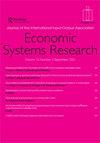投入产出分析中资本内生的供给-使用方法
IF 1.6
4区 经济学
Q2 ECONOMICS
引用次数: 9
摘要
投入产出分析目前将资本投资视为行业间系统的外生因素,尽管资本产品在生产过程中被进一步使用。先前的研究已经应用Leontief演算将资本的影响纳入足迹计算。在这里,我们采用了一种供应-使用方法,通过构建资本供应-使用表(KSUT)来将资本纳入足迹计算,从而区分资本货物。由于新的KSUT形式符合联合国国民账户体系中的供应-使用形式,我们可以在计算影响乘数的整个过程中保持完全透明。我们在澳大利亚经济的案例研究中证明了KSUT框架的有用性,并从EXIOBASE3数据库中进行了环境扩展。如果在联合国气候变化框架公约中考虑基于消费的排放,KSUT框架将为确定各国对当前使用和资本投资的碳排放的责任提供一致和透明的基础。本文章由计算机程序翻译,如有差异,请以英文原文为准。
A supply-use approach to capital endogenization in input–output analysis
Input–output analysis currently treats capital investment as exogenous to the inter-industry system despite capital goods being used further in production processes. Previous studies have applied the Leontief calculus to include impacts of capital in footprint calculations. Here, we adopt a supply-use approach to incorporating capital into footprint calculations, by constructing capital supply-use tables (KSUTs) that enable differentiating capital goods. As the new KSUT formalism is compliant with the Supply-Use formalism in the UN's System of National Accounts, we can keep full transparency throughout the process of calculating impact multipliers. We demonstrate the usefulness of the KSUT framework in a case study of the Australian economy, with environmental extensions from the EXIOBASE3 database. If consumption-based emissions were considered for the UN's Framework Convention on Climate Change, the KSUT framework would provide a consistent and transparent foundation for working out countries’ responsibility for carbon emissions from both current use and capital investment.
求助全文
通过发布文献求助,成功后即可免费获取论文全文。
去求助
来源期刊

Economic Systems Research
ECONOMICS-
CiteScore
5.60
自引率
4.00%
发文量
17
期刊介绍:
Economic Systems Research is a double blind peer-reviewed scientific journal dedicated to the furtherance of theoretical and factual knowledge about economic systems, structures and processes, and their change through time and space, at the subnational, national and international level. The journal contains sensible, matter-of-fact tools and data for modelling, policy analysis, planning and decision making in large economic environments. It promotes understanding in economic thinking and between theoretical schools of East and West, North and South.
 求助内容:
求助内容: 应助结果提醒方式:
应助结果提醒方式:


